User:Jacobfrid/sandbox6
County Kerry
Contae Chiarraí | |
|---|---|
| Nickname: The Kingdom | |
| Motto(s): | |
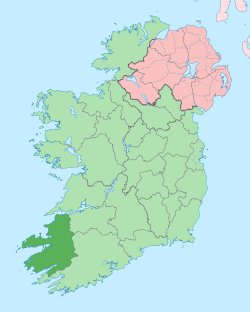 Location in Ireland | |
| Coordinates: 52°10′N 9°45′W / 52.167°N 9.750°W | |
| Country | Ireland |
| Province | Munster |
| Established | c. 1232[1] |
| County town | Tralee |
| Government | |
| • Type | Kerry County Council |
| • Dáil Éireann | Kerry |
| • European Parliament | South |
| Area | |
• Total | 4,807 km2 (1,856 sq mi) |
| • Rank | 5th |
| Highest elevation | 1,039 m (3,409 ft) |
| Population (2016)[2] | |
• Total | 147,707 |
| • Rank | 15th |
| • Density | 31/km2 (80/sq mi) |
| Time zone | UTC±0 (WET) |
| • Summer (DST) | UTC+1 (IST) |
| Eircode routing keys | V23, V31, V92, V93 (primarily) |
| Telephone area codes | 064, 066, 068 (primarily) |
| Website | www |
County Kerry (Irish: Contae Chiarraí) is a county in the South-West Region of Ireland, within the province of Munster. It is bordered by two other counties; Limerick to the east, and Cork to the south and east. It is separated from Clare to the north by the Shannon Estuary. With an area of 4,807 square kilometres (1,856 sq mi) and a population of 156,458 as of 2022, it is the 5th largest of Ireland's 32 counties by land area, and the 15th most populous. The governing local authority is Kerry County Council.
Bounded by the Atlantic Ocean, Kerry is Ireland's most westerly county. Its rugged coastline stretches for 886 kilometres (551 miles) and is characterised by bays, sea cliffs, beaches and many small offshore islands, of which the Blaskets and the Skelligs are the most notable.[3] The county's peninsulas have a hilly to mountainous topography, with the MacGillycuddy's Reeks on Iveragh rising to over 1,000 m (3,300 ft). By contrast, its interior regions are mostly flat, interspersed with low mountain ranges such as the Stacks and the Mullaghareirks. The climate of Kerry is dominated by the North Atlantic Current and is usually mild and humid, with abundant precipitation. This allows for the growth of a wide variety of temperate and sub-tropical plants not typically found at such northerly latitudes.[4]
The county is named after the Cíarraige people, who were the region's dominant pre-historic sept. County Kerry first appeared as a separate shire in 1232, and was at that time part of a royal grant given to the Earls of Desmond. The present-day county was divided for centuries between the Gaelic Kingdom of Desmond, ruled by the Mac Cárthaigh dynasty, and the Anglo-Norman Earldom of Desmond, ruled by the Geraldines. These two regions were merged in 1606 in the aftermath of the Nine Years' War.[5]
Kerry has two official Gaeltacht regions, Gaeltacht Uíbh Ráthaigh on the Iveragh Peninsula and Gaeltacht Corca Dhuibhne on the Dingle Peninsula, the latter of which is the only Gaeltacht in Munster where Irish is the daily spoken language of the majority of the population. In the county as a whole, 40.2 percent of residents were able to speak Irish as of 2022.[6] The regional dialect is Munster Irish, exemplified by the influential works of Blasket Islanders such as Peig Sayers, Muiris Ó Súilleabháin and Tomás Ó Criomhthain.
Toponymy
[edit]
The name Kerry is an anglicisation of the Irish word Ciarraí, which is derived from the toponym Cíarraige, meaning "the people of Ciar". Ciar in this instance refers to the "Kingdom of Ciar", a prehistoric Gaelic kingdom located in the northwest of modern-day County Kerry. The area was inhabited by a branch of the Cíarraige people known as the Ciarraige Luachra, and is therefore sometimes referred to as the "Kingdom of Luachra" in certain historical sources, such as the Annals of Inisfallen. Another subdivision, the Ciarraige Altraige, lived around Tralee and on the Dingle Peninsula, bounded to the west by the Kingdom of Corcu Duibne, which was inhabited by the Érainn people.
The Cíarraige were the reputed descendants of Ciar Mac Fergus, a banished son of Fergus mac Róich, the King of Ulster, and Medb, the Queen of Connacht. toponym Ciar raige, later Gallaecia, related to the name of an ancient Celtic tribe that resided north of the Douro river, the Gallaeci or Callaeci in Latin, or Καλλαϊκoί (Kallaïkoí) in Greek. These Callaeci were the first tribe in the area to help the Lusitanians against the invading Romans. The Romans applied their name to all the other tribes in the northwest who spoke the same language and lived the same life.[7]
County Kerry is widely referred to by its colloquial nickname The Kingdom. Contemporary historians recognise the nickname as having originated "Ciar",
In the 19th century, Irish writer Thomas Davis mistakenly attributed this nickname to a speech delivered by John Philpot Curran in the Irish House of Commons in 1787. Although Davis notes that Curran "seems to have originated the phrase", the term was most likely in common colloquial use by the time of Curran's speech.
The origins are from the Old Irish Ciar raige - from ciar meaning "black, dark", and lind (IPA: [lʲiɲ(d̪ʲ)]) "pool", referring to a dark tidal pool.
The toponymy of the name has been studied since the 7th century by authors such as Isidore of Seville, who wrote that "Galicians are called so, because of their fair skin, as the Gauls", relating the name to the Greek word for milk. (See the etymology of the word galaxy.) In the 21st century, some scholars (J.J. Moralejo, Carlos Búa) have derived the name of the ancient Callaeci either from Proto-Indo-European *kl(H)-no- 'hill',[8] through a local relational suffix -aik-, also attested in Celtiberian, so meaning 'the hill (people)'; or either from Proto-Celtic *kallī- 'forest', so meaning 'the forest (people)'.[9][10] In any case, Galicia, being per se a derivation of the ethnic name Kallaikói, means 'the land of the Galicians'.
Another recent proposal comes from linguist Francesco Benozzo after identifying the root gall- / kall- in a number of Celtic words with the meaning "stone" or "rock", as follows: gall (old Irish), gal (Middle Welsh), gailleichan (Scottish Gaelic), kailhoù (Breton), galagh (Manx) and gall (Gaulish). Hence, Benozzo explains the ethnonym Callaeci as being "the stone people" or "the people of the stone" ("those who work with stones"), in reference to the builders of the ancient megaliths and stone formations so common in Galicia.[11]
History
[edit]Prehistory and antiquity
[edit]
The oldest attestation of human presence in Galicia has been found in the Eirós Cave, in the municipality of Triacastela, which has preserved animal remains and Neanderthal stone objects from the Middle Paleolithic. The earliest culture to have left significant architectural traces is the Megalithic culture, which expanded along the western European coasts during the Neolithic and Calcolithic eras. Thousands of Megalithic tumuli are distributed throughout the country, but mostly along the coastal areas.[12] Within each tumulus is a stone burial chamber known locally as anta (dolmen), frequently preceded by a corridor. Galicia was later influenced by the Bell Beaker culture. Its rich mineral deposits of tin and gold led to the development of Bronze Age metallurgy, and to the commerce of bronze and gold items all along the Atlantic coast of Western Europe. A shared elite culture evolved in this region during the Atlantic Bronze Age.

Dating from the end of the Megalithic era, and up to the Bronze Age, numerous stone carvings (petroglyphs) are found in open air. They usually represent cup and ring marks, labyrinths, deer, Bronze Age weapons, and riding and hunting scenes.[13] Large numbers of these stone carvings can be found in the Rías Baixas regions, at places such as Tourón and Campo Lameiro.

The Castro culture[14] ('Culture of the Castles') developed during the Iron Age, and flourished during the second half of the first millennium BC. It is usually considered a local evolution of the Atlantic Bronze Age, with later developments and influences and overlapping into the Roman era. Geographically, it corresponds to the people the Romans called Gallaeci, which were composed of a large series of nations or tribes, among them the Artabri, Bracari, Limici, Celtici, Albiones and Lemavi. They were capable fighters: Strabo described them as the most difficult foes the Romans encountered in conquering Lusitania, while Appian[15] mentions their warlike spirit, noting that the women bore their weapons side by side with their men, frequently preferring death to captivity. According to Pomponius Mela all the inhabitants of the coastal areas were Celtic people.

Gallaeci lived in castros. These were usually annular forts, with one or more concentric earthen or stony walls, with a trench in front of each one. They were frequently located at hills, or in seashore cliffs and peninsulas. Some well known castros can be found on the seashore at: Fazouro, Santa Tegra, Baroña, and O Neixón; and inland at: San Cibrao de Lás, Borneiro, Castromao, and Viladonga. Some other distinctive features, such as temples, baths, reservoirs, warrior statues and decorative carvings have been found associated to this culture, together with rich gold and metalworking traditions.

The Roman legions first entered the area under Decimus Junius Brutus in 137–136 BC,[16] but the country was only incorporated into the Roman Empire by the time of Augustus (29 BC – 19 BC). The Romans were interested in Galicia mainly for its mineral resources, most notably gold. Under Roman rule, most Galician hillforts began to be – sometimes forcibly – abandoned, and Gallaeci served frequently in the Roman army as auxiliary troops. Romans brought new technologies, new travel routes, new forms of organizing property, and a new language; Latin. The Roman Empire established its control over Galicia through camps (castra) as Aquis Querquennis, Ciadella camp or Lucus Augusti (Lugo), roads (viae) and monuments as the lighthouse known as Tower of Hercules, in Corunna, but the remoteness and lesser interest of the country since the 2nd century of our era, when the gold mines stopped being productive, led to a lesser degree of Romanization. In the 3rd century it was made a province, under the name Gallaecia, which included also northern Portugal, Asturias, and a large section of what today is known as Castile and León.
Early Middle Ages
[edit]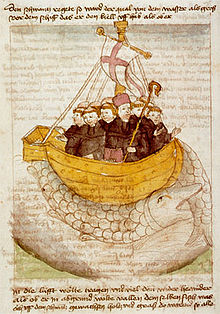
In the early 5th century, the deep crisis suffered by the Roman Empire allowed different tribes of Central Europe (Suebi, Vandals and Alani) to cross the Rhine and penetrate into the rule on 31 December 406. Its progress towards the Iberian Peninsula forced the Roman authorities to establish a treaty (foedus) by which the Suebi would settle peacefully and govern Galicia as imperial allies. So, from 409 Galicia was taken by the Suebi, forming the first medieval kingdom to be created in Europe, in 411, even before the fall of the Roman Empire, being also the first Germanic kingdom to mint coinage in Roman lands. During this period a Briton colony and bishopric (see Mailoc) was established in Northern Galicia (Britonia), probably as foederati and allies of the Suebi. In 585, the Visigothic King Leovigild invaded the Suebic kingdom of Galicia and defeated it, bringing it under Visigoth control.
Later the Muslims invaded Spain (711), but the Arabs and Moors never managed to have any real control over Galicia, which was later incorporated into the expanding Christian Kingdom of Asturias, usually known as Gallaecia or Galicia (Yillīqiya and Galīsiya) by Muslim chroniclers,[17] as well as by many European contemporaries.[18] This era consolidated Galicia as a Christian society which spoke a Romance language. During the next century Galician noblemen took northern Portugal, conquering Coimbra in 871, thus freeing what was considered the southernmost city of ancient Galicia.
High and Low Middle Ages
[edit]
In the 9th century, the rise of the cult of the Apostle James in Santiago de Compostela gave Galicia a particular symbolic importance among Christians, an importance it would hold throughout the Reconquista. As the Middle Ages went on, Santiago became a major pilgrim destination and the Way of Saint James (Camiño de Santiago) a major pilgrim road, a route for the propagation of Romanesque art and the words and music of the troubadors. During the 10th and 11th centuries, a period during which Galician nobility become related to the royal family, Galicia was at times headed by its own native kings, while Vikings (locally known as Leodemanes or Lordomanes) occasionally raided the coasts. The Towers of Catoira[19] (Pontevedra) were built as a system of fortifications to prevent and stop the Viking raids on Santiago de Compostela.
In 1063, Ferdinand I of Castile divided his realm among his sons, and the Kingdom of Galicia was granted to Garcia II of Galicia. In 1072, it was forcibly annexed by Garcia's brother Alfonso VI of León; from that time Galicia was united with the Kingdom of León under the same monarchs. In the 13th century Alfonso X of Castile standardized the Castilian language (i.e. Spanish) and made it the language of court and government. Nevertheless, in his Kingdom of Galicia the Galician language was the only language spoken, and the most used in government and legal uses, as well as in literature.

During the 14th and 15th centuries, the progressive distancing of the kings from Galician affairs left the kingdom in the hands of the local knights, counts and bishops, who frequently fought each other to increase their fiefs, or simply to plunder the lands of others. At the same time, the deputies of the Kingdom in the Cortes stopped being called. The Kingdom of Galicia, slipping away from the control of the King, responded with a century of fiscal insubordination.

On the other hand, the lack of an effective royal justice system in the Kingdom led to the social conflict known as the Guerras Irmandiñas ('Wars of the brotherhoods'), when leagues of peasants and burghers, with the support of a number of knights, noblemen, and under legal protection offered by the remote king, toppled many of the castles of the Kingdom and briefly drove the noblemen into Portugal and Castile. Soon after, in the late 15th century, in the dynastic conflict between Isabella I of Castile and Joanna La Beltraneja, part of the Galician aristocracy supported Joanna. After Isabella's victory, she initiated an administrative and political reform which the chronicler Jeronimo Zurita defined as "doma del Reino de Galicia": 'It was then when the taming of Galicia began, because not just the local lords and knights, but all the people of that nation were the ones against the others very bold and warlike'. These reforms, while establishing a local government and tribunal (the Real Audiencia del Reino de Galicia), and bringing the nobleman under submission, also brought most Galician monasteries and institutions under Castilian control, in what has been criticized as a process of centralisation. At the same time the kings began to call the Xunta or Cortes of the Kingdom of Galicia, an assembly of deputies or representatives of the cities of the Kingdom, to ask for monetary and military contributions. This assembly soon developed into the voice and legal representation of the Kingdom, and the depositary of its will and laws.
Early Modern
[edit]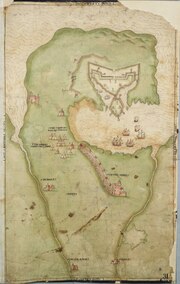
The modern period of the kingdom of Galicia began with the defeat of some of the most powerful Galician lords, such as Pedro Álvarez de Sotomayor, called Pedro Madruga, and Rodrigo Henriquez Osorio, at the hands of the Castilian armies sent to Galicia between the years 1480 and 1486. Isabella I of Castile, considered a usurper by many Galician nobles, defeated all armed resistance and definitively established the royal power of the Castilian monarchy. Fearing a general revolt, the monarchs ordered the banishing of the rest of the great lords like Pedro de Bolaño, Diego de Andrade or Lope Sánchez de Moscoso, among others.

The establishment of the Santa Hermandad in 1480, and of the Real Audiencia del Reino de Galicia in 1500—a tribunal and executive body directed by the Governor-Captain General as a direct representative of the King—implied initially the submission of the Kingdom to the Crown,[20] after a century of unrest and fiscal insubordination. As a result, from 1480 to 1520 the Kingdom of Galicia contributed more than 10% of the total earnings of the Crown of Castille, including the Americas, well over its economic relevance.[21] Like the rest of Spain, the 16th century was marked by population growth up to 1580, when the simultaneous wars with the Netherlands, France and England hampered Galicia's Atlantic commerce, which consisted mostly in the exportation of sardines, wood, and some cattle and wine.
In the late years of the 15th century the written form of the Galician language began a slow decline as it was increasingly replaced by Spanish, which would culminate in the Séculos Escuros "the Dark Centuries" of the language, roughly from the 16th century through to the mid-18th century, when written Galician almost completely disappeared except for private or occasional uses but the spoken language remained the common language of the people in the villages and even the cities.
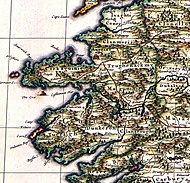
From that moment Galicia, which participated to a minor extent in the American expansion of the Spanish Empire, found itself at the center of the Atlantic wars fought by Spain against the French and the Protestant powers of England and the Netherlands, whose privateers attacked the coastal areas, but major assaults were not common as the coastline was difficult and the harbors easily defended. The most famous assaults were upon the city of Vigo by Sir Francis Drake in 1585 and 1589, and the siege of A Coruña in 1589 by the English Armada. Galicia also suffered occasional slave raids by Barbary pirates, but not as frequently as the Mediterranean coastal areas. The most famous Barbary attack was the bloody sack of the town of Cangas in 1617.[22] At the time, the king's petitions for money and troops became more frequent, due to the human and economic exhaustion of Castile; the Junta of the Kingdom of Galicia (the local Cortes or representative assembly) was initially receptive to these petitions, raising large sums, accepting the conscription of the men of the kingdom, and even commissioning a new naval squadron which was sustained with the incomes of the Kingdom.[23]
After the rupture of the wars with Portugal and Catalonia, the Junta changed its attitude, this time due to the exhaustion of Galicia, now involved not just in naval or oversea operations, but also in an exhausting war with the Portuguese, war which produced thousands of casualties and refugees and was heavily disturbing to the local economy and commerce. So, in the second half of the 17th century the Junta frequently denied or considerably reduced the initial petitions of the monarch, and though the tension didn't rise to the levels experienced in Portugal or Catalonia, there were frequent urban mutinies and some voices even asked for the secession of the Kingdom of Galicia.[24]
19th century
[edit]


During the Peninsular War the successful uprising of the local people against the new French authorities, together with the support of the British Army, limited the occupation to a six-month period in 1808–1809. During the pre-war period the Supreme Council of the Kingdom of Galicia (Junta Suprema del Reino de Galicia), auto-proclaimed interim sovereign in 1808, was the sole government of the country and mobilized near 40,000 men against the invaders.
The 1833 territorial division of Spain put a formal end to the Kingdom of Galicia, unifying Spain into a single centralized monarchy. Instead of seven provinces and a regional administration, Galicia was reorganized into the current four provinces. Although it was recognized as a "historical region", that status was strictly honorific. In reaction, nationalist and federalist movements arose.
The liberal General Miguel Solís Cuetos led a separatist coup attempt in 1846 against the authoritarian regime of Ramón María Narváez. Solís and his forces were defeated at the Battle of Cacheiras, 23 April 1846, and the survivors, including Solís himself, were shot. They have taken their place in Galician memory as the Martyrs of Carral or simply the Martyrs of Liberty.
Defeated on the military front, Galicians turned to culture. The Rexurdimento focused on recovery of the Galician language as a vehicle of social and cultural expression. Among the writers associated with this movement are Rosalía de Castro, Manuel Murguía, Manuel Leiras Pulpeiro, and Eduardo Pondal.
In the early 20th century came another turn toward nationalist politics with Solidaridad Gallega (1907–1912) modeled on Solidaritat Catalana in Catalonia. Solidaridad Gallega failed, but in 1916 Irmandades da Fala (Brotherhood of the Language) developed first as a cultural association but soon as a full-blown nationalist movement. Vicente Risco and Ramón Otero Pedrayo were outstanding cultural figures of this movement, and the magazine Nós ('Us'), founded 1920, its most notable cultural institution, Lois Peña Novo the outstanding political figure.
The Second Spanish Republic was declared in 1931. During the republic, the Partido Galeguista (PG) was the most important of a shifting collection of Galician nationalist parties. Following a referendum on a Galician Statute of Autonomy, Galicia was granted the status of an autonomous region.
Galicia was spared the worst of the fighting in that war: it was one of the areas where the initial coup attempt at the outset of the war was successful, and it remained in Nationalist hands (Franco's army) throughout the war. While there were no pitched battles, there was repression and death: all political parties were abolished, as were all labor unions and Galician nationalist organizations as the Seminario de Estudos Galegos. Galicia's statute of autonomy was annulled (as were those of Catalonia and the Basque provinces once those were conquered). According to Carlos Fernández Santander, at least 4,200 people were killed either extrajudicially or after summary trials, among them republicans, communists, Galician nationalists, socialists and anarchists. Victims included the civil governors of all four Galician provinces.
20th century and contemporary
[edit]
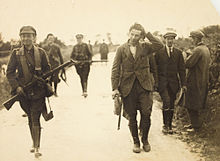
Juana Capdevielle, the wife of the governor of A Coruña; mayors such as Ánxel Casal of Santiago de Compostela, of the Partido Galeguista; prominent socialists such as Jaime Quintanilla in Ferrol and Emilio Martínez Garrido in Vigo; Popular Front deputies Antonio Bilbatúa, José Miñones, Díaz Villamil, Ignacio Seoane, and former deputy Heraclio Botana); soldiers who had not joined the rebellion, such as Generals Rogelio Caridad Pita and Enrique Salcedo Molinuevo and Admiral Antonio Azarola; and the founders of the PG, Alexandre Bóveda and Víctor Casas,[25] as well as other professionals akin to republicans and nationalists, as the journalist Manuel Lustres Rivas or physician Luis Poza Pastrana. Many others were forced to escape into exile, or were victims of other reprisals and removed from their jobs and positions. General Francisco Franco – himself a Galician from Ferrol – ruled as dictator from the civil war until his death in 1975. Franco's centralizing regime suppressed any official use of the Galician language, including the use of Galician names for newborns, although its everyday oral use was not forbidden. Among the attempts at resistance were small leftist guerrilla groups such as those led by José Castro Veiga ("O Piloto") and Benigno Andrade ("Foucellas"), both of whom were ultimately captured and executed.[26][27] In the 1960s, ministers such as Manuel Fraga Iribarne introduced some reforms allowing technocrats affiliated with Opus Dei to modernize administration in a way that facilitated capitalist economic development. However, for decades Galicia was largely confined to the role of a supplier of raw materials and energy to the rest of Spain, causing environmental havoc and leading to a wave of migration to Venezuela and to various parts of Europe. Fenosa, the monopolistic supplier of electricity, built hydroelectric dams, flooding many Galician river valleys.

The Galician economy finally began to modernize with a French Citroën factory in Vigo, the modernization of the canning industry and the fishing fleet, and eventually a modernization of small peasant farming practices, especially in the production of cows' milk. In the province of Ourense, businessman and politician Eulogio Gómez Franqueira gave impetus to the raising of livestock and poultry by establishing the Cooperativa Orensana S.A. (Coren).
During the last decade of Franco's rule, there was a renewal of nationalist feeling in Galicia. The early 1970s were a time of unrest among university students, workers, and farmers. In 1972, general strikes in Vigo and Ferrol cost the lives of Amador Rey and Daniel Niebla.[28] Later, the bishop of Mondoñedo-Ferrol, Miguel Anxo Araúxo Iglesias, wrote a pastoral letter that was not well received by the Franco regime, about a demonstration in Bazán (Ferrol) where two workers died.[29]
As part of the transition to democracy upon the death of Franco in 1975, Galicia regained its status as an autonomous region within Spain with the Statute of Autonomy of 1981, which begins, "Galicia, historical nationality, is constituted as an Autonomous Community to access to its self-government, in agreement with the Spanish Constitution and with the present Statute (...)". Varying degrees of nationalist or independentist sentiment are evident at the political level. The Bloque Nacionalista Galego or BNG, is a conglomerate of left-wing parties and individuals that claims Galician political status as a nation.
Geography
[edit]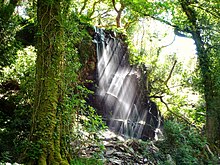
Kerry covers an area of 4,807 square kilometres (1,856 sq mi), making it the second largest county in Munster and the 5th largest in Ireland. With a population of just under 148,000 as of 2016, it is the 15th most populous of Ireland's 32 traditional counties, and the fourth most populous of Munster's six counties. Its population density is 30.7 people per km2, making it the fourth least densely populated county on the island.
Situated in the southwest corner of Ireland, Kerry borders just two other counties - Limerick to the east, and Cork to the south and east. All three counties meet at the Striolán Bridge along the River Feale, and there is a scenic viewpoint marking the location. Clare is located to north across the Shannon Estuary, a distance of just 1.8 kilometres (1.1 mi) at its narrowest crossing between Tarbert and Kilkerrin Point. The county town is Tralee, located in northern Kerry, approximately 97 kilometres (60 mi) from Limerick, 101 kilometres (63 mi) from Cork, and 294 kilometres (183 mi) from Dublin.
Topography
[edit]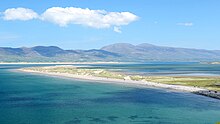
The interior of Galicia is a hilly landscape, composed of relatively low mountain ranges, usually below 1,000 m (3,300 ft) high, without sharp peaks, rising to 2,000 m (6,600 ft) in the eastern mountains. There are many rivers, most (though not all) running down relatively gentle slopes in narrow river valleys, though at times their courses become far more rugged, as in the canyons of the Sil river, Galicia's second most important river after the Miño.

Topographically, a remarkable feature of Galicia is the presence of many firth-like inlets along the coast, estuaries that were drowned with rising sea levels after the ice age. These are called rías and are divided into the smaller Rías Altas ("High Rías"), and the larger Rías Baixas ("Low Rías"). The Rías Altas include Ribadeo, Foz, Viveiro, O Barqueiro, Ortigueira, Cedeira, Ferrol, Betanzos, A Coruña, Corme e Laxe and Camariñas. The Rías Baixas, found south of Fisterra, include Corcubión, Muros e Noia, Arousa, Pontevedra and Vigo. The Rías Altas can sometimes refer only to those east of Estaca de Bares, with the others being called Rías Medias ("Intermediate Rías").
Erosion by the Atlantic Ocean has contributed to the great number of capes. Besides the aforementioned Estaca de Bares in the far north, separating the Atlantic Ocean from the Cantabrian Sea, other notable capes are Cape Ortegal, Cape Prior, Punta Santo Adrao, Cape Vilán, Cape Touriñán (westernmost point in Galicia), Cape Finisterre or Fisterra, considered by the Romans, along with Finistère in Brittany and Land's End in Cornwall, to be the end of the known world.
Islands and peninsulas
[edit]

All along the Galician coast are various archipelagos near the mouths of the rías. These archipelagos provide protected deepwater harbors and also provide habitat for seagoing birds. A 2007 inventory estimates that the Galician coast has 316 archipelagos, islets, and freestanding rocks.[30] Among the most important of these are the archipelagos of Cíes, Ons, and Sálvora. Together with Cortegada Island, these make up the Atlantic Islands of Galicia National Park. Other significant islands are Islas Malveiras, Islas Sisargas, and, the largest and holding the largest population, Arousa Island.
Its westernmost point is Great Foze Rock, an islet 5.3 kilometres (3.3 mi) southwest of Tearaght Island. At 10°41′26"W, Great Foze Rock is also one of the westernmost points of Europe, after Iceland and the Azores. The coast of this 'green corner' of the Iberian Peninsula, some 1,500 km (930 mi) in length, attracts great numbers of tourists, although real estate development in the 2000–2010 decade have degraded it partially.
Galicia is quite mountainous, a fact which has contributed to isolate the rural areas, hampering communications, most notably in the inland. The main mountain range is the Macizo Galaico (Serra do Eixe, Serra da Lastra, Serra do Courel), also known as Macizo Galaico-Leonés, located in the eastern parts, bordering with Castile and León. Noteworthy mountain ranges are O Xistral (northern Lugo), the Serra dos Ancares (on the border with León and Asturias), O Courel (on the border with León), O Eixe (the border between Ourense and Zamora), Serra de Queixa (in the center of Ourense province), O Faro (the border between Lugo and Pontevedra), Cova da Serpe (border of Lugo and A Coruña), Montemaior (A Coruña), Montes do Testeiro, Serra do Suído, and Faro de Avión (between Pontevedra and Ourense); and, to the south, A Peneda, O Xurés and O Larouco, all on the border of Ourense and Portugal.
The highest point in Galicia is Trevinca or Pena Trevinca (2,124 metres or 6,969 feet), located in the Serra do Eixe, at the border between Ourense and León and Zamora provinces. Other[31] tall peaks are Pena Survia (2,112 metres or 6,929 feet) in the Serra do Eixe, O Mustallar (1,935 metres or 6,348 feet) in Os Ancares, and Cabeza de Manzaneda (1,782 metres or 5,846 feet) in Serra de Queixa, where there is a ski resort.

Geology
[edit]
Galicia has preserved some of its dense forests. It is relatively unpolluted, and its landscapes composed of green hills, cliffs and rias are generally different from what is commonly understood as Spanish landscape. Nevertheless, Galicia has some important environmental problems.
Deforestation and forest fires are a problem in many areas, as is the continual spread of the eucalyptus tree, a species imported from Australia, actively promoted by the paper industry since the mid-20th century. Galicia is one of the more forested areas of Spain, but the majority of Galicia's plantations, usually growing eucalyptus or pine, lack any formal management.[32] Massive eucalyptus plantation, especially of Eucalyptus globulus, began in the Francisco Franco era, largely on behalf of the paper company Empresa Nacional de Celulosas de España (ENCE) in Pontevedra, which wanted it for its pulp. Galician photographer Delmi Álvarez began documenting the fires in Galicia from 2006 in a project called Queiman Galiza (Burn Galicia)..[33] Wood products figure significantly in Galicia's economy. Apart from tree plantations Galicia is also notable for the extensive surface occupied by meadows used for animal husbandry, especially cattle, an important activity. Hydroelectric development in most rivers has been a serious concern for local conservationists during the last decades.
Fauna, most notably the European wolf, has suffered because of the actions of livestock owners and farmers, and because of the loss of habitats, whilst the native deer species have declined because of hunting and development.
Oil spills are a major issue. The Prestige oil spill in 2002 spilt more oil than the Exxon Valdez in Alaska.
Biodiversity
[edit]

Galicia has more than 2,800 plant species and 31 endemic plant taxa. Plantations and mixed forests of eucalyptus predominates in the west and north; a few oak forests (variously known locally as fragas or devesas) remain, particularly in the north-central part of the province of Lugo and the north of the province of A Coruña (Fragas do Eume). In the interior regions of the country, oak and bushland predominates. Galicia has 262 inventoried species of vertebrates, including 12 species of freshwater fish, 15 amphibians, 24 reptiles, 152 birds, and 59 mammals.[34]
The animals most often thought of as being "typical" of Galicia are the livestock raised there. The Galician horse is native to the region, as is the Galician Blond cow and the domestic fowl known as the galiña de Mos. The last is an endangered species, although it is showing signs of a comeback since 2001.[35]
Galicia is home to one of the largest population of wolves in western Europe. Galicia's woodlands and mountains are also home to rabbits, hares, wild boars, and roe deer, all of which are popular with hunters. Several important bird migration routes pass through Galicia, and some of the community's relatively few environmentally protected areas are Special Protection Areas (such as on the Ría de Ribadeo) for these birds. From a domestic point of view, Galicia has been credited for author Manuel Rivas as the "land of one million cows". Galician Blond and Holstein cattle coexist on meadows and farms.
Climate
[edit]


Kerry's climate is dominated by the Gulf Stream and the North Atlantic Current, giving the county exceptionally mild winters when compared with areas of a similar latitude on the opposite side of the Atlantic Ocean, such as Newfoundland. The county has a temperate maritime climate (Cfb) under the Köppen climate classification, with coastal areas bordering on a humid subtropical climate (Cf) under the Trewartha classification.
Kerry has a narrow annual temperature range, characterised by cool to warm summers, mild winters and relative humidity over 75% virtually year-round. As a result of its topography and south-westerly location, Kerry is the wettest county in Ireland. All areas of the county will receive over 1,000 millimetres (39.4 in) of rainfall in a typical year, with totals exceeding 3,000 millimetres (118.1 in) not uncommon in mountainous areas.
Along coastal areas, summers are tempered by the ocean, with average daily high temperatures in August peaking at 18.2 °C (64.8 °F) in Valentia. Temperatures are about one or two degrees higher inland, with Killorglin recording an average July maximum of 19.8 °C (67.6 °F). The county's record high temperature is 32.0 °C (89.6 °F), set on 6 July 2006 at Killorglin. The coldest temperature ever recorded in Kerry, also at Killorglin, was −12.5 °C (9.5 °F) on 23 December 2010.
Owing to the moderating influence of the Gulf Stream, much of Kerry's coast lies within Hardiness zone 10, a plant survival climate range typically found in the Caribbean. The 30-year average annual extreme minimum temperature at Valentia is −1.5 °C (29.3 °F), and the area experiences just 0.5 days of lying snow per year. The station at Valentia also records more 'tropical nights' than anywhere else in Ireland, where nighttime temperatures do not fall below 20 °C (68 °F). As a result of its unique climate, Kerry hosts some of the rarest plant species in Europe, such as the Kerry Mousetail Fern (Stenogrammitis myosuroides), which is native to the cloud forests of Jamaica, and Blue-eyed-grass (Sisyrinchium bermudiana), native to Bermuda.
The prevailing southwesterly winds also bring a considerable amount of cloud to the county. However, as a result of the region's unpredictable and high changeable weather, sunshine hours can vary considerably from year to year. For example, between 1990 and 2000, Valentia Island recorded an average of 1,063 hours of sunshine per year, whereas from 2000 to 2010 it recorded an average of 1,558 hours of sunshine per year, an almost 50% difference.
Climate data for some locations in Kerry:[36]
| Station | July av. high | January av. low | Record high | Record low | Annual rainfall | Rainy days (>1mm) | Period |
|---|---|---|---|---|---|---|---|
| Ardfert (Liscahane) |
19.7 °C (67.5 °F) | 3.6 °C (38.5 °F) | 31.6 °C (88.9 °F) | −11.8 °C (10.8 °F) | 1,171 mm (46.1 in) | 1991-2020 | |
| Listowel (Gurtocloughane) |
19.1 °C (66.4 °F) | 3.4 °C (38.1 °F) | 30.4 °C (86.7 °F) | −6.7 °C (19.9 °F) | 1,449 mm (57.0 in) | 2013-2020 | |
| Killorglin (Dooks) |
19.8 °C (67.6 °F) | 4.6 °C (40.3 °F) | 32.0 °C (89.6 °F) | −12.5 °C (9.5 °F) | 1,302 mm (51.3 in) | 2000-2020 | |
| Valentia | 18.1 °C (64.6 °F) | 4.7 °C (40.5 °F) | 29.7 °C (85.5 °F) | −7.7 °C (18.1 °F) | 1,557 mm (61.3 in) | 1981-2010 | |
| Dingle (Ventry) |
- | - | - | - | 1,209 mm (47.6 in) | 1991-2020 | |
| Cloon Lough (Cloone Lake) |
- | - | - | - | 2,830 mm (111.4 in) | 1991-2020 |
Government and politics
[edit]Local government
[edit]Galicia has partial self-governance, in the form of a devolved government, established on 16 March 1978 and reinforced by the Galician Statute of Autonomy, ratified on 28 April 1981. There are three branches of government: the executive branch, the Xunta de Galicia, consisting of the President and the other independently elected councillors;[37] the legislative branch consisting of the Galician Parliament; and the judicial branch consisting of the High Court of Galicia and lower courts.
Executive
[edit]
The Xunta de Galicia is a collective entity with executive and administrative power. It consists of the President, a vice president, and twelve councillors. Administrative power is largely delegated to dependent bodies. The Xunta also coordinates the activities of the provincial councils (Galician: deputacións) located in A Coruña, Pontevedra, Ourense and Lugo.
The President of the Xunta directs and coordinates the actions of the Xunta. He or she is simultaneously the representative of the autonomous community and of the Spanish state in Galicia. He or she is a member of the parliament and is elected by its deputies and then formally named by the monarch of Spain.
Legislative
[edit]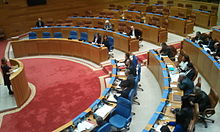
The Galician Parliament[38] consists of 75 deputies elected by universal adult suffrage under a system of proportional representation. The franchise includes also Galicians who reside abroad. Elections occur every four years.
The last elections, held 12 July 2020, resulted in the following distribution of seats:[39]
- Partido Popular de Galicia (PPdeG): 41 deputies (47.98% of popular vote)
- Bloque Nacionalista Galego (BNG): 19 deputies (23.80% of popular vote)
- Partido Socialista de Galicia (PSdeG-PSOE): 15 deputies (19.38% of popular vote)
Judicial
[edit]Municipal governments
[edit]There are 314 municipalities (Galician: concellos) in Galicia, each of which is run by a mayor–council government known as a concello.
There is a further subdivision of local government known as an Entidade local menor; each has its own council (xunta veciñal) and mayor (alcalde da aldea). There are nine of these in Galicia: Arcos da Condesa, Bembrive, Camposancos, Chenlo, Morgadáns, Pazos de Reis, Queimadelos, Vilasobroso and Berán.
Galicia is also traditionally subdivided in some 3,700 civil parishes, each one comprising one or more vilas (towns), aldeas (villages), lugares (hamlets) or barrios (neighbourhoods).
National government
[edit]Galicia's interests are represented at national level by 25 elected deputies in the Congress of Deputies and 19 senators in the Senate – of these, 16 are elected and 3 are appointed by the Galician parliament.
Administrative divisions
[edit]Prior to the 1833 territorial division of Spain Galicia was divided into seven administrative provinces:[40]
Galicia is further divided into 53 comarcas, 315 municipalities (93 in A Coruña, 67 in Lugo, 92 in Ourense, 62 in Pontevedra) and 3,778 parishes. Municipalities are divided into parishes, which may be further divided into aldeas ("hamlets") or lugares ("places"). This traditional breakdown into such small areas is unusual when compared to the rest of Spain. Roughly half of the named population entities of Spain are in Galicia, which occupies only 5.8 percent of the country's area. It is estimated that Galicia has over a million named places, over 40,000 of them being communities.[41]
Demographics
[edit]| Year | Pop. | ±% |
|---|---|---|
| 1900 | 1,980,515 | — |
| 1910 | 2,063,589 | +4.2% |
| 1920 | 2,124,244 | +2.9% |
| 1930 | 2,230,281 | +5.0% |
| 1940 | 2,495,860 | +11.9% |
| 1950 | 2,604,200 | +4.3% |
| 1960 | 2,602,962 | −0.0% |
| 1970 | 2,683,674 | +3.1% |
| 1981 | 2,811,942 | +4.8% |
| 1991 | 2,731,669 | −2.9% |
| 2001 | 2,695,880 | −1.3% |
| 2011 | 2,772,928 | +2.9% |
| 2017 | 2,710,607 | −2.2% |
| Source: INE | ||
Population
[edit]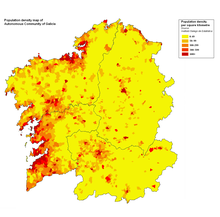
Galicia's inhabitants are known as Galicians (Galician: galegos, Spanish: gallegos). For well over a century Galicia has grown more slowly than the rest of Spain, due largely to a poorer economy compared with other regions of Spain and emigration to Latin America and to other parts of Spain. Sometimes Galicia has lost population in absolute terms. In 1857, Galicia had Spain's densest population and constituted 11.5% of the national population. As of 2007[update], only 6.1% of the Spanish population resided in the autonomous community. This is due to an exodus of Galician people since the 19th century, first to South America and later to Central Europe[where?] and to the development of population centers and industry in other parts of Spain.
According to the 2006 census, Galicia has a fertility rate of 1.03 children per woman, compared to 1.38 nationally, and far below the figure of 2.1 that represents a stable populace.[42] Lugo and Ourense provinces have the lowest fertility rates in Spain, 0.88 and 0.93, respectively.[42]
In northern Galicia, the A Coruña-Ferrol metropolitan area has become increasingly dominant in terms of population. The population of the city of A Coruña in 1900 was 43,971. The population of the rest of the province, including the City and Naval Station of nearby Ferrol and Santiago de Compostela, was 653,556. A Coruña's growth occurred after the Spanish Civil War at the same speed as other major Galician cities, but since the revival of democracy after the death of Francisco Franco, A Coruña has grown at a faster rate than all the other Galician cities.
During the mid-20th century, the population rapidly increased in A Coruña, Vigo, and to a lesser degree, other major Galician cities, like Ourense, Pontevedra or Santiago de Compostela as the rural population declined after the Spanish Civil War: many villages and hamlets of the four provinces of Galicia disappeared or nearly disappeared during the same period. Economic development and mechanization of agriculture resulted in the fields being abandoned, and most of the population moving to find jobs in the main cities. The number of people working in the tertiary and quaternary sectors of the economy increased significantly.
Since 1999, the absolute number of births in Galicia has been increasing. In 2006, 21,392 births were registered in Galicia,[43] 300 more than in 2005, according to the Instituto Galego de Estatística. Since 1981, the Galician life expectancy has increased by five years, thanks to a higher quality of life.[44][45]
- Birth rate (2006): 7.9 per 1,000 (all of Spain: 11.0 per 1,000)
- Death rate (2006): 10.8 per 1,000 (all of Spain: 8.4 per 1,000)
- Life expectancy at birth (2005): 80.4 years (all of Spain: 80.2 years)
- Male: 76.8 years (all of Spain: 77.0 years)
- Female: 84.0 years (all of Spain: 83.5 years)
The largest conurbations are:
- Pontevedra-Vigo 660,000
- A Coruña-Ferrol 640,000
| List of municipalities in Galicia by population | ||||||||||
|---|---|---|---|---|---|---|---|---|---|---|
| Municipality | Province | Population (2020) | Municipality | Province | Population (2020) | |||||
| 1 | Vigo | Pontevedra | 296,692 | 13 | Carballo | A Coruña | 31,429 | |||
| 2 | A Coruña | A Coruña | 247,604 | 14 | Culleredo | A Coruña | 30,685 | |||
| 3 | Ourense | Ourense | 105,643 | 15 | Redondela | Pontevedra | 29,241 | |||
| 4 | Lugo | Lugo | 98,519 | 16 | Ribeira | A Coruña | 26,848 | |||
| 5 | Santiago de Compostela | A Coruña | 97,848 | 17 | Cangas | Pontevedra | 26,582 | |||
| 6 | Pontevedra | Pontevedra | 83,260 | 18 | Cambre | A Coruña | 24,594 | |||
| 7 | Ferrol | A Coruña | 65,560 | 19 | Marín | Pontevedra | 24,242 | |||
| 8 | Narón | A Coruña | 39,056 | 20 | Ponteareas | Pontevedra | 22,940 | |||
| 9 | Vilagarcía de Arousa | Pontevedra | 37,565 | 21 | A Estrada | Pontevedra | 20,351 | |||
| 10 | Oleiros | A Coruña | 36,534 | 22 | Lalín | Pontevedra | 20,207 | |||
| 11 | Arteixo | A Coruña | 32,738 | 23 | O Porriño | Pontevedra | 20,100 | |||
| 12 | Ames | A Coruña | 32,104 | 24 | Moaña | Pontevedra | 19,452 | |||
Migration
[edit]Like many rural areas of Western Europe, Galicia's history has been defined by mass emigration. Significant internal migration took place from Galicia in the late 19th and early 20th centuries to the industrialized Spanish cities of Barcelona, Bilbao, Zaragoza and Madrid. Other Galicians emigrated to Latin America – Argentina, Uruguay, Venezuela, Mexico, Brazil and Cuba in particular.
The two cities with the greatest number of people of Galician descent outside Galicia are Buenos Aires, Argentina, and nearby Montevideo, Uruguay. Immigration from Galicia was so significant in these areas that Argentines and Uruguayans now commonly refer to all Spaniards as gallegos (Galicians).[46]
During the Franco years, there was a new wave of emigration out of Galicia to other European countries, most notably to France, Germany, Switzerland, and the United Kingdom. Many of these immigrant or expatriate communities have their own groups or clubs, which they formed in the first decades of settling in a new place. The Galician diaspora is so widespread that websites such as Fillos de Galicia have been created in the 21st century to organize and form a network of ethnic Galicians throughout the world.
After this, a third wave was a Spanish internal emigration to heavier industrialised areas of Spain, like the Basque Country or Catalunya.
The proportion of foreign-born people in Galicia is only 2.9 percent compared to a national figure of 10 percent; among the autonomous communities, only Extremadura has a lower percentage of immigrants.[47] Of the foreign nationals resident in Galicia, 17.93 percent are the ethnically related Portuguese, 10.93 percent are Colombian and 8.74 percent Brazilian.[48]
Language
[edit]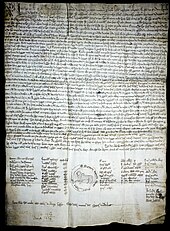
Galicia has two official languages: Galician (Galician: galego) and Spanish (also known in Spain as castellano, i.e. "Castilian"), both of them Romance languages. Galician originated regionally; the latter was associated with Castile. Galician is recognized in the Statute of Autonomy of Galicia as the lingua propia ("own language") of Galicia.
Galician is closely related to Portuguese. Both share a common medieval phase known as Galician-Portuguese.[49] The independence of Portugal since the late Middle Ages has favored the divergence of the Galician and Portuguese languages as they developed.[50] Though considered to be independent languages in Galicia, the shared history between Galician and Portuguese has been widely acknowledged; in 2014, the Galician parliament approved Law 1/2014 on the promotion of Portuguese and links with the Lusophony.[51]
The official Galician language has been standardized by the Real Academia Galega on the basis of literary tradition. Although there are local dialects, Galician media conform to this standard form, which is also used in primary, secondary, and university education. There are more than three million Galician speakers in the world.[50] Galician ranks in the lower orders of the 150 most widely spoken languages on earth.[48]
For more than four centuries of Castilian domination, Spanish was the only official language in Galicia. Galician faded from day-to-day use in urban areas. Since the re-establishment of democracy in Spain—in particular since passage and implementation of the Lei de Normalización Lingüística ("Law of Linguistic Normalization", Ley 3/1983, 15 June 1983)—the first generation of students in mass education has attended schools conducted in Galician. (Spanish is also taught.)
Since the late 20th century and the establishment of Galicia's autonomy, the Galician language is resurgent. In the cities, it is generally used as a second language for most. According to a 2001 census, 99.16 percent of the population of Galicia understood the language, 91.04 percent spoke it, 68.65 percent could read it and 57.64 percent could write it.[52] The first two numbers (understanding and speaking) were roughly the same as responses a decade earlier. But there were great gains among the percentage of the population who could read and write Galician: a decade earlier, only 49.3 percent of the population could read Galician, and 34.85 percent could write it. During the Franco era, the teaching of Galician was prohibited. Today older people may speak the language but have no written competence because of those years.[52] Among the regional languages of Spain, Galician has the highest percentage of speakers in its population.
The earliest known document in Galician-Portuguese dates from 1228. The Foro do bo burgo do Castro Caldelas was granted by Alfonso IX of León to the town of Burgo, in Castro Caldelas, after the model of the constitutions of the town of Allariz.[53] A distinct Galician literature emerged during the Middle Ages: In the 13th century important contributions were made to the Romance canon in Galician-Portuguese, the most notable those by the troubadour Martín Codax, the priest Airas Nunes, King Denis of Portugal, and King Alfonso X of Castile, Alfonso O Sabio ("Alfonso the Wise"), the same monarch who began the process of standardization of the Spanish language. During this period, Galician-Portuguese was considered the language of love poetry in the Iberian Romance linguistic culture. The names and memories of Codax and other popular cultural figures are well preserved in modern Galicia.
Religion
[edit]
Religion in Kerry (2022)[54]
Christianity is the most widely practised religion in Galicia. It was introduced in Late Antiquity and was practiced alongside the native Celtic religion for a few centuries which, incidentally, was re-established as an officially recognised religion in 2015.[55] Still, today about 77.7% of Galicians identify as Catholic.[56] Most Christians adhere to Roman Catholicism, though only 32.1% of the population described themselves as active members. The Catholic Church in Galicia has had its primatial seat in Santiago de Compostela since the 12th century.
Since the Middle Ages, the Galician Catholic Church has been organized into five ecclesiastical dioceses (Lugo, Ourense, Santiago de Compostela, Mondoñedo-Ferrol and Tui-Vigo). While these may have coincided with contemporary 15th-century civil provinces, they no longer have the same boundaries as the modern civil provincial divisions. The church is led by one archbishop and four bishops. The five dioceses of Galicia are divided among 163 districts and 3,792 parishes. A few are governed by administrators, the remainder by parish priests.
The patron saint of Galicia is Saint James the Greater. According to Catholic tradition, his body was discovered in 814 near Compostela. After that date, the relics of Saint James attracted an extraordinary number of pilgrims. Since the 9th century these relics have been kept in the heart of the church – the modern-day cathedral – dedicated to him. There are many other Galician and associated saints; some of the best-known are: Saint Ansurius, Saint Rudesind, Saint Mariña of Augas Santas, Saint Senorina, Trahamunda and Froilan.
Economy
[edit]Industry and Energy
[edit]

Textiles, fishing, livestock, forestry and car manufacturing are the most dynamic sectors of the Galician economy.
The companies based in the province of Coruña generate 70% of the entrepreneurial output of Galicia.[57] Arteixo, an industrial municipality in the A Coruña metropolitan area, is the headquarters of Inditex, the world's largest fashion retailer. Of their eight brands, Zara is the best-known; indeed, it is the best-known Spanish brand of any sort on an international basis.[58] For 2007, Inditex had 9,435 million euros in sales for a net profit of 1,250 million euros.[59] The company president, Amancio Ortega, is the richest person in Spain[60] and indeed Europe[61] with a net worth of 45 billion euros.
A major economic sector of Galicia is its fishing Industry; the main ports are A Coruña, Marín-Pontevedra, Vigo and Ferrol. Related to this fact, the European Fisheries Control Agency, which coordinates fishing controls in European Union waters, is based in Vigo.
Galicia is a land of economic contrast. While the western coast, with its major population centers and its fishing and manufacturing industries, is prosperous and increasing in population, the rural hinterland—the provinces of Ourense and Lugo—is economically dependent on traditional agriculture, based on small landholdings called minifundios. However, the rise of tourism, sustainable forestry and organic and traditional agriculture are bringing other possibilities to the Galician economy without compromising the preservation of the natural resources and the local culture.
Tourism
[edit]
Traditionally, Galicia depended mainly on agriculture and fishing. Nonetheless, today the tertiary sector of the economy (the service sector) is the largest, with 582,000 workers out of a regional total of 1,072,000 (as of 2002).
The secondary sector (manufacturing) includes shipbuilding in Vigo, Marín-Pontevedra and Ferrol, textiles and granite work in A Coruña. A Coruña also manufactures automobiles. The French Centro de Vigo de PSA Peugeot Citroën, founded in 1958, makes about 450,000 vehicles annually (455,430 in 2006);[62] a Citroën C4 Picasso made in 2007 was their nine-millionth vehicle.[63]
Other companies with a large number of workers and a significant turnover are San José, based in Pontevedra, belonging to the construction sector, and Gadisa and Vego, based in A Coruña and Froiz, based in Pontevedra, linked to the retail sector.[64]
Galicia is home to the savings bank, and to Spain's two oldest commercial banks Banco Etcheverría (the oldest) and Banco Pastor, owned since 2011 by Banco Popular Español. Nearly 1 in 5 jobs in the county is dependent on tourism <Tourism Recovery Plan 2020 - 2023
Galicia was late to catch the tourism boom that has swept Spain in recent decades, but the coastal regions (especially the Rías Baixas and Santiago de Compostela) are now significant tourist destinations and are especially popular with visitors from other regions in Spain, where the majority of tourists come from. In 2007, 5.7 million tourists visited Galicia, an 8% growth over the previous year, and part of a continual pattern of growth in this sector.[65] 85% of tourists who visit Galicia visit Santiago de Compostela.[65] Tourism constitutes 12% of Galician GDP and employs about 12% of the regional workforce.[65]
The Gross domestic product (GDP) of the autonomous community was 62.6 billion euros in 2018, accounting for 5.2% of Spanish economic output. GDP per capita adjusted for purchasing power was 24,900 euros or 82% of the EU27 average in the same year. The GDP per employee was 95% of the EU average.[66]
Infrastructure
[edit]Road
[edit]The main National Primary Routes into Kerry are the N21 road from Limerick and the N22 road from Cork, each terminating in Tralee. Kerry Airport is situated on the N23 road between Castleisland and Farranfore which connects the N21 and N22. Within Kerry the main National Secondary Routes include the well-known Ring of Kerry which follows the N70 road that circles the Iveragh Peninsula and links at Kenmare with the N71 road to west Cork. The N86 road connects Tralee with Dingle along the Dingle Peninsula, while the N69 road from Limerick links Listowel and Tralee through north Kerry.
Greenways
[edit]There is a developing greenway network across the county. The North Kerry (part of the Great Southern Trail), South Kerry and Tralee-Fenit greenways are under-development or in the planning phases.
Rail
[edit]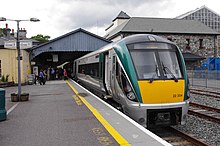
Kerry is served by rail at Tralee railway station, Farranfore railway station, Killarney railway station and Rathmore railway station which connect to Cork and Dublin Heuston, via Mallow.
Branch line services existed to each of the peninsulas (Beara, Iveragh and Dingle) and also to the north of the county. They were closed during the rationalisations of the 1950s and 1960s.
- Tralee and Dingle Light Railway: a narrow-gauge railway that closed in July 1953.
- Kenmare via Headford Junction: (8 miles outside Killarney) closed in early 1960.[67]
- Valentia Harbour via Farranfore: also closed in early 1960.[citation needed] The Gleesk Viaduct near Kells, the viaduct at Killorglin, and many other structures on the line still exist.
- Listowel was served via the North Kerry line, which extended from Tralee to Limerick. Passenger service ceased in 1963, freight in 1983 and the lines were pulled up in 1988.
- Fenit was served via a branch off the North Kerry line until 1978; the rails are still in place.
Listowel to Ballybunion had the distinction of operating experimental Lartigue Monorail services from 1882 to 1924. A 500m section was re-established in 2003. A road-car route, the Prince of Wales Route, was a link from Bantry to Killarney, operated by the Cork, Bandon and South Coast Railway as a service for tourists.
Bus
[edit]Bus Éireann operates an extensive bus service network on routes throughout the county, with connection hubs in Killarney and Tralee.
Various local link services also run throughout Kerry such as the soon to be launched 274 from Tralee to Tarbert via Ardfert, Ballyheigue, Ballyduff and Ballybunion. Note that this new Local Link 274 will replace the return journey on the Bus Eireann 274. See https://www.locallinkkerry.ie/ for all buses operated by them throughout the county.
Air
[edit]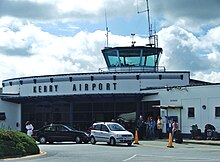
Kerry Airport is located at Farranfore in the centre of the county and has operated scheduled services since 1989. Destinations served as of 2014 are London (Stansted & Luton), Frankfurt-Hahn Airport, Faro, Portugal and Alicante all operated by Ryanair. Aer Lingus Regional also operate an all-year-round service to Dublin. The airport is served by Farranfore railway station.
Sea
[edit]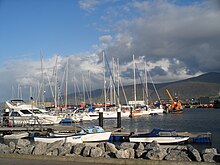
Fenit harbour near Tralee is a regional harbour capable of handling ships of up to 17,000 tonnes. Large container cranes from Liebherrs in Killarney are regularly exported worldwide. A rail-link to the port was closed in the 1970s. The harbour at Dingle is one of Ireland's secondary fishing ports.[citation needed][68] In the north of the county, a ferry service operates from Tarbert to Killimer in County Clare.
Hospitals
[edit]Hospitals in Kerry include the public University Hospital Kerry which is the second-largest acute hospital in the Health Service Executive South Region. It serves as the main hospital for County Kerry and also serves the people in parts of north Cork and west Limerick. Other hospitals include the private Bon Secours Hospital in Tralee and community hospitals in Cahirciveen, Dingle, Kenmare, Killarney and Listowel.
Education
[edit]The Munster Technological University (MTU), former the Institute of Technology, Tralee, is the main third-level institution in the county. It was established in 1977 as the Regional Technical College, Tralee but acquired its present name in 1997. The Institute of Technology, Tralee, merged with Cork Institute of Technology in 2019 to form the Munster Technological University. It has an enrolment of about 3,500 students. The institute has two campuses: the North Campus (opened in Dromtacker in 2001) and the South Campus (opened in Clash in 1977) approximately 2.4 km (1.5 mi) apart.
Culture
[edit]
Hundreds of ancient standing stone monuments like dolmens, menhirs and megalithic tumuli were erected during the prehistoric period in Galicia. Amongst the best-known are the dolmens of Dombate, Corveira, Axeitos of Pedra da Arca, and menhirs like the Lapa de Gargñáns. From the Iron Age, Galicia has a rich heritage based mainly on a great number of hill forts, few of them excavated like Baroña, Sta. Tegra, San Cibrao de Lás and Formigueiros among others. With the introduction of Ancient Roman architecture there was a development of basilicas, castra, city walls, cities, villas, Roman temples, Roman roads, and the Roman bridge of Ponte Vella. It was the Romans who founded some of the first cities in Galicia like Lugo and Ourense. Perhaps the best-known examples are the Roman Walls of Lugo and the Tower of Hercules in A Coruña.

During the Middle Ages, many fortified castles were built by Galician feudal nobles to mark their powers against their rivals. Although most of them were demolished during the Irmandiño Wars (1466–1469), some Galician castles that survived are Pambre, Castro Caldelas, Sobroso, Soutomaior and Monterrei. Ecclesiastical architecture raised early in Galicia, and the first churches and monasteries as San Pedro de Rocas, began to be built in the 5th and 6th centuries. However, the most famous medieval architecture in Galicia had been using Romanesque architecture like most of Western Europe. Some of the greatest examples of Romanesque churches in Galicia are the Cathedral of Santiago de Compostela, the Ourense Cathedral, Saint John of Caaveiro, Our Lady Mary of Cambre and the Church of San Xoán of Portomarín among others.

Galician cuisine often uses fish and shellfish. The empanada is a meat or fish pie, with a bread-like base, top and crust with the meat or fish filling usually being in a tomato sauce including onions and garlic. Caldo galego is a hearty soup whose main ingredients are potatoes and a local vegetable named grelo (broccoli rabe). The latter is also employed in lacón con grelos, a typical carnival dish, consisting of pork shoulder boiled with grelos, potatoes and chorizo. Centolla is the equivalent of king crab. It is prepared by being boiled alive, having its main body opened like a shell, and then having its innards mixed vigorously. Another popular dish is octopus, boiled (traditionally in a copper pot) and served in a wooden plate, cut into small pieces and laced with olive oil, sea salt and pimentón (Spanish paprika). This dish is called pulpo a la gallega or in Galician polbo á feira, which roughly translates as 'fair-style octopus', most commonly translated as 'Galician-style octopus'. There are several regional varieties of cheese. The best-known one is the so-called tetilla, named after its breast-like shape. Other highly regarded varieties include the San Simón cheese from Vilalba and the creamy cheese produced in the Arzúa-Ulloa area. A classical is filloas, crêpe-like pancakes made with flour, broth or milk, and eggs. When cooked at a pig slaughter festival, they may also contain the animal's blood. A famous almond cake called Tarta de Santiago (St. James' cake) is a Galician sweet speciality mainly produced in Santiago de Compostela and all around Galicia.

Galicia has 30 products with Denominación de orixe (D.O.), some of them with Denominación de Orixe Protexida (D.O.P.).[69] D.O. and D.O.P. are part of a system of regulation of quality and geographical origin among Spain's finest producers. Galicia produces a number of high-quality Galician wines, including Albariño, Ribeiro, Ribeira Sacra, Monterrei and Valdeorras. The grape varieties used are local and rarely found outside Galicia and Northern Portugal. Just as notably from Galicia comes the spirit Augardente—the name means burning water—often referred to as Orujo in Spain and internationally or as caña in Galicia. This spirit is made from the distillation of the pomace of grapes.
Music
[edit]Folk and traditionally based music
[edit]The traditional music of Galicia and Asturias features highly distinctive folk styles that have some similarities with the neighboring area of Cantabria. The music is characterized by the use of bagpipes.
- Luar na Lubre: a band inspired by traditional Galician music. They have collaborated with Mike Oldfield and other musicians.
- Carlos Núñez: he has also collaborated with a great number of artists, being notable his long-term friendship with The Chieftains.
- Susana Seivane: virtuoso piper. She descends from a family of pipe makers and stated she preferred pipes instead of dolls during her childhood.
- Milladoiro
- Cristina Pato: Galician bagpiper and member of Yo-Yo Ma's Silk Road Ensemble.
Pop and rock
[edit]- Andrés Suárez: singer-songwriter from Ferrol, known for his poetic, insightful and often romantic lyrics.
- Los Suaves: hard rock/heavy metal band active since the early 1980s, from Ourense
- Deluxe: pop/rock band from A Coruña led by Xoel López
- Siniestro Total: punk rock
- Os Resentidos: led by Antón Reixa in the 1980s
- Heredeiros da Crus: rock band singing in Galician language
Hip-hop
[edit]- Dios Ke Te Crew: powerful band of hip-hop with social compromised lyrics.
Literature, poetry and philosophy
[edit]
As with many other Romance languages, Galician-Portuguese emerged as a literary language in the Middle Ages, during the 12th and 13th centuries, when a rich lyric tradition developed, followed by a minor prose tradition, whilst being the predominant language used for legal and private texts till the 15th century. However, in the face of the hegemony of Spanish, during the so-called Séculos Escuros ("Dark Centuries") from 1530 to the late 18th century, it fell from major literary or legal written use.
As a literary language it was revived again during the 18th and, most notably, the 19th-century (Rexurdimento Resurgence) with such writers as Rosalía de Castro, Manuel Murguía, Manuel Leiras Pulpeiro, and Eduardo Pondal. In the 20th century, before the Spanish Civil War the Irmandades da Fala ("Brotherhood of the Language") and Grupo Nós included such writers as Vicente Risco, Ramón Cabanillas and Castelao. Public use of Galician was largely suppressed during the Franco dictatorship but has been resurgent since the restoration of democracy. Contemporary writers in Galician include Xosé Luís Méndez Ferrín, Manuel Rivas, Chus Pato, and Suso de Toro.
Public holidays
[edit]- Día de San Xosé (St. Joseph's Day) on 19 March (strictly religious)
- Día do Traballo (May Day) on 1 May
- Día das Letras Galegas (Galician Literature Day) on 17 May
- Día da Patria Galega (Galicia's National Day) also known as St. James the Apostle Day on 25 July
- Día da Nosa Señora (Day of Our Lady) on 15 August (strictly religious)
Festivals
[edit]
- Entroido, or Carnival, is a traditional celebration in Galicia, historically disliked and even forbidden by the Catholic Church. Famous celebrations are held in Laza, Verín, and Xinzo de Limia.
- Festa do Corpus Christi in Ponteareas, has been observed since 1857 on the weekend following Corpus Christi (a movable feast) and is known for its floral carpets. It was declared a Festival of Tourist Interest in 1968 and a Festival of National Tourist Interest in 1980.
- Feira Franca, first weekend of September, in Pontevedra recreates an open market that first occurred in 1467. The fair commemorates the height of Pontevedra's prosperity in the 15th and 16th centuries, through historical recreation, theater, animation, and demonstration of artistic activities. Held annually since 2000.
- Arde Lucus, in June, celebrates the Celtic and Roman history of the city of Lugo, with recreations of a Celtic weddings, Roman circus, etc.
- Bonfires of Saint John, Noite de San Xoán or Noite da Queima is widely spread in all Galician territory, celebrated as a welcome to the summer solstice since the Celtic period, and Christianized in Saint John's day eve. Bonfires are believed to make meigas (malicious or fallen witches), to flee. They are particularly relevant in the city of Corunna, where it became Fiesta of National Tourist Interest of Spain. The whole city participate on making great bonfires in each district, whereas the centre of the party is located in the beaches of Riazor and Orzan, in the very city heart, where hundreds of bonfires of different sizes are lighted. Also, grilled sardines are very typical.
- Rapa das Bestas ("shearing of the beasts") in Sabucedo, the first weekend in July, is the most famous of a number of rapas in Galicia and was declared a Festival of National Tourist Interest in 1963. Wild colts are driven down from the mountains and brought to a closed area known as a curro, where their manes are cut and the animals are marked, and assisted after a long winter in the hills. In Sabucedo, unlike in other rapas, the aloitadores ("fighters") each take on their task with no assistance.
- Festival de Ortigueira (Ortigueira's Festival of Celtic World) lasts four days in July, in Ortigueira. First celebrated 1978–1987 and revived in 1995, the festival is based in Celtic culture, folk music, and the encounter of different peoples throughout Spain and the world. Attended by over 100,000 people, it is considered a Festival of National Tourist Interest.
- Festa da Dorna, 24 July, in Ribeira. Founded 1948, declared a Galician Festival of Tourist Interest in 2005. Founded as a joke by a group of friends, it includes the Gran Prix de Carrilanas, a regatta of hand-made boats; the Icarus Prize for Unmotorized Flight; and a musical competition, the Canción de Tasca.
- Festas do Apóstolo Santiago (Festas of the Apostle James): the events in honor of the patron saint of Galicia last for half a month. The religious celebrations take place 24 July. Celebrants set off fireworks, including a pyrotechnic castle in the form of the façade of the cathedral.
- Romería Vikinga de Catoira ("Viking Festival of Catoira"), first Sunday in August, is a secular festival that has occurred since 1960 and was declared a Festival of International Tourist Interest in 2002. It commemorates the historic defense of Galicia and the treasures of Santiago de Compostela from Norman and Saracen pirate attacks.
- Festas da Peregrina in Pontevedra, 2nd week of August, celebrating the Pilgrim Virgin of Pontevedra. There is a bullfighting festival at the same time. Pontevedra is the only city where there is a permanent bullring.
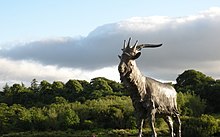
- Festa de San Froilán, 4–12 October, celebrating the patron saint of the city of Lugo. A Festival of National Tourist Interest, the festival was attended by 1,035,000 people in 2008.[70] It is most famous for the booths serving polbo á feira, an octopus dish.
- Festa do marisco (Seafood festival), October, in O Grove. Established 1963; declared a Festival of National Tourist Interest in the 1980s.
In 2015 only five corridas took place within Galicia.[71] In addition, recent studies have stated that 92% of Galicians are firmly against bullfighting, the highest rate in Spain. Despite this, popular associations, such as Galicia Mellor Sen Touradas ("Galicia Better without Bullfights"), have blamed politicians for having no compromise in order to abolish it and have been very critical of local councils', especially those governed by the PP and PSOE, payment of subsidies for corridas. The province government of Pontevedra stopped the end of these subsidies and declared the province "free of bullfights".[72] The province government of A Coruña approved a document supporting the abolition of these events.[73]
Media
[edit]County Kerry has two local newspapers, The Kerryman and Kerry's Eye, both published in Tralee.
The county has a commercial radio station, Radio Kerry, which commenced operations in 1990. RTÉ Raidió na Gaeltachta has a studio in Baile na nGall in the west Kerry gaeltacht.[74] Spin South West has a studio in Tralee, which commenced operations in 2016.
Sport
[edit]Galicia has a long sporting tradition dating back to the early 20th century, when the majority of sports clubs in Spain were founded. The most popular and well-supported teams in the region are Deportivo La Coruña and Celta Vigo. When the two sides play, it is referred to as the Galician derby. Deportivo was champion of La Liga in the 1999–2000 season.
Pontevedra CF from Pontevedra and Racing Ferrol from Ferrol are two other notable clubs from Galicia as well as CD Lugo and SD Compostela. The Galician Football Federation periodically fields a national team against international opposition. This fact causes some political controversy because matches involving other national football teams different from the Spanish official national team threaten its status as the one and only national football team of the State. The policy of centralization in sport is very strong as it is systematically used as a patriotic device with which to build a symbol of the supposed unity of Spain which is actually a plurinational State.
Football aside, the most popular team sports in Galicia are futsal, handball and basketball. In basketball, Obradoiro CAB is the most successful team of note, and currently the only Galician team that plays in the Liga ACB; other teams are CB Breogan, Club Ourense Baloncesto and OAR Ferrol. In the sport of handball, Club Balonmán Cangas plays in the top-flight (Liga ASOBAL). The sport is particularly popular in the province of Pontevedra with the three other Galician teams in the top two divisions: SD Teucro (Pontevedra), Octavio Pilotes Posada (Vigo) and SD Chapela (Redondela).
In roller hockey HC Liceo is the most successful Galician team, in any sport, with numerous European and World titles. In futsal teams, Lobelle Santiago and Azkar Lugo.
Galicia is also known for its tradition of participation in water sports both at sea and in rivers; these include rowing, yachting, canoeing and surfing. Its athletes have regularly won medals in the Olympics; currently the most notable examples are David Cal, Carlos Pérez Rial and Fernando Echavarri.
Galician triathlon contenders Francisco Javier Gómez Noya and Iván Raña have been world champions. In 2006 the cyclist Oscar Pereiro won the Tour de France after the disqualification of American Floyd Landis, gaining the top position on the penultimate day of the race. Galicians are also prominent athletes in the sport of mountaineering—Chus Lago is the third woman to reach the summit of Everest without supplemental oxygen.
Emerging sports
[edit]Since 2011, several Gaelic football teams have been set up in Galicia. The first was Fillos de Breogán (A Coruña), followed Artabros (Oleiros), Irmandinhos (A Estrada), SDG Corvos (Pontevedra), and Suebia (Santiago de Compostela) with talk of creating a Galician league.[75] Galicia also fielded a Gaelic football side (recognised as national by the GAA) that beat Brittany in July 2012 and was reported in the Spanish nationwide press.[76]
Rugby is growing in popularity, although the success of local teams is hampered by the absence of experienced expat players from English-speaking countries typically seen at teams based on the Mediterranean coast or in the big cities. Galicia has a long established Rugby Federation that organises its own women's, children's and men's leagues. Galicia has also fielded a national side for friendly matches against other regions of Spain and against Portugal. A team of expat Galicians in Salvador, Brazil have also formed Galicia Rugby, a sister team of the local football club.
Places of interest
[edit]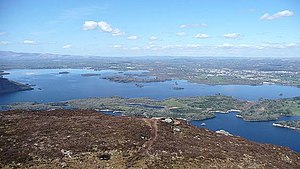
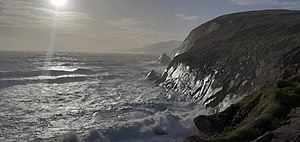
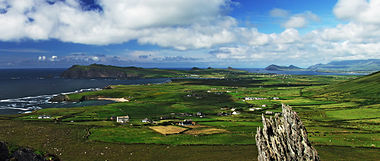
Kerry, with its mountains, lakes and nearly 1,000 kilometres of Atlantic coastline is among the most scenic areas in Ireland and is among the most significant tourist destinations in Ireland. Killarney is the centre of the tourism industry, which is a significant element of the economy in Kerry. The Kerry Way, Dingle Way and Beara Way are walking routes in the county. The Ring of Kerry on the Iveragh Peninsula is a popular route for tourists and cyclists. The pedestrian version is the scenic Kerry Way which follows ancient paths generally higher than that adopted by the Ring of Kerry.
Kerry has an abundance of archaeological sites. The earliest evidence of human settlement dates to the Mesolithic period.[77] The county has a notably high concentration of open-air Atlantic rock art, which is believed to date to the Late Neolithic / Early Bronze Age period (2300-1500BC). This rock art is scattered throughout the county and exists in dense clusters on the Iveragh and Dingle peninsulas. These carvings form part of a tradition which stretches across Atlantic Europe and are distinct from the megalithic art of the type found at Newgrange.[78] Kerry has many Bronze Age monuments including standing stones, wedge tombs, boulder burials, and stone circles, along with Iron Age forts. Like the rest of Ireland, Kerry has large numbers of monuments from the Early Christian period, such as ring forts, churches, cross-inscribed stones, holy wells, saints' graves, and ogham stones, along with Medieval castles and churches.
Attractions:
- Ballinskelligs
- Banna Strand
- Blasket Islands
- Blennerville Windmill
- Caragh Lake
- Carrauntoohil
- Conor Pass
- Dingle Peninsula
- Eightercua
- Ecclesiastical sites at Ardfert
- Fenit Harbour
- Gallarus Oratory
- Killarney National Park
- Kerry County Museum
- Kerry Woollen Mills
- Lakes of Killarney
- Lartigue Monorail
- Maharees
- Mount Brandon
- Muckross House
- Rattoo Round Tower and Sheela na Gig
- Ring of Kerry
- Ross Castle
- Rossbeigh beach
- Scotia's Grave
- Siamsa Tíre
- Skellig Michael
- Torc Waterfall
- Uragh Stone Circle
- Valentia Island
Notable people
[edit]- ^ "Kerry - Topographical Dictionary of Ireland (1837)". www.libraryireland.com. Archived from the original on 21 June 2019. Retrieved 21 June 2019.
- ^ "Census 2016 Sapmap Area: County Kerry". Central Statistics Office (Ireland). Archived from the original on 28 October 2018. Retrieved 27 October 2018.
- ^ "The Relative Lengths of Seashore Substrata Around the Coastline of Ireland as Determined by Digital Methods in a Geographical Information System". Environmental Sciences Unit, Trinity College, Dublin. 22 April 1999. Retrieved 13 July 2021.
- ^ "Europe's smallest and rarest fern turns up in the west of Ireland – from the tropical cloud-forest?" (PDF). Botanical Society of Britain and Ireland. 5 October 2020. Retrieved 20 May 2024.
- ^ (Falkiner 1903, p. 192-3)
- ^ "Profile 8 - The Irish Language and Education F8015 - Irish speakers aged 3 years and over". census.cso.ie. Retrieved 29 January 2024.
- ^ Luján, Eugenio R. (2000): "Ptolemy's 'Callaecia' and the language(s) of the 'Callaeci', in Ptolemy: towards a linguistic atlas of the earliest Celtic place-names of Europe : papers from a workshop sponsored by the British Academy, Dept. of Welsh, University of Wales, Aberystwyth, 11–12 April 1999, pp. 55–72. Parsons and Patrick Sims-Williams editors.
- ^ Búa, Carlos (2018). Toponimia prelatina de Galicia. Santiago de Compostela: USC. p. 213. ISBN 978-84-17595-07-4.
- ^ Curchin, Leonard A. (2008) Estudios GallegosThe toponyms of the Roman Galicia: New Study. CUADERNOS DE ESTUDIOS GALLEGOS LV (121): 111.
- ^ Cite error: The named reference
Moralejowas invoked but never defined (see the help page). - ^ Benozzo, F. (2018) "Uma paisagem atlântica pré-histórica. Etnogénese e etno-filologia paleo-mesolítica das tradições galega e portuguesa", in proceedings of Jornadas das Letras Galego-Portuguesas 2015–2017, DTS, Università di Bologna and Academia Galega da Língua Portuguesa, pp. 159–170.
- ^ Antonio de la Peña Santos, Los orígenes del asentamiento humano Archived 24 May 2013 at the Wayback Machine, (chapters 1 and 2 of the book Historia de Pontevedra A Coruña:Editorial Vía Láctea, 1996. p. 23.
- ^ de la Peña García, Antonio (2001). Petroglifos de Galicia. Perillo-Oleiros (A Coruña): Vía Láctea. ISBN 84-89444-82-X.
- ^ Parcero-Oubiña C. and Cobas-Fernández, I (2004). Iron Age Archaeology of the Northwest Iberian Peninsula Archived 24 June 2011 at the Wayback Machine. In e-Keltoi, Volume 6: 1–72. UW System Board of Regents, 2004. ISSN 1540-4889.
- ^ History of Rome: the Spanish Wars, 72–73.
- ^ Livy lv., lvi., Epitome
- ^ Cf. Carballeira Debasa, Ana María (2007). Galicia y los gallegos en las fuentes árabes medievales. Madrid: Consejo Superior de Investigaciones Científicas. ISBN 978-84-00-08576-6.
- ^ Alfonso II of Asturias was addressed as: "DCCXCVIII. Venit etiam et legatus Hadefonsi regis Galleciae et Asturiae, nomine Froia, papilionem mirae pulchritudinis praesentans. (...) Hadefonsus rex Galleciae et Asturiae praedata Olisipona ultima Hispaniae civitate insignia victoriae suae loricas, mulos captivosque Mauros domno regi per legatos suos Froiam et Basiliscum hiemis tempore misit". (ANNALES REGNI FRANCORUM); "Hadefuns rex Gallaeciae Carolo prius munera pretiosa itemque manubias suas pro munere misit". (CODEX AUGIENSIS); "Galleciarum princeps" (VITA LUDOVICI) Cf. López Carreira, Anselmo (2005): O Reino medieval de Galicia. A Nosa Terra, Vigo. ISBN 978-84-8341-293-0 pp. 211–248.
- ^ Eduardo Loureiro. "Viking Festival webpage". Catoira.net. Retrieved 26 April 2010.
- ^ Mariño Paz, Ramón (1998). Historia da lingua galega (2. ed.). Santiago de Compostela: Sotelo Blanco. p. 195. ISBN 84-7824-333-X.
- ^ Rubio Martínez, Amparo (2010). "LOS INGRESOS EXTRAORDINARIOS DEL REINO DE GALICIA EN EL SIGLO XV". Cuadernos de Estudios Gallegos. LVII (126): 268. Retrieved 4 July 2012.
- ^ Martínez Crespo, José (2007). A guerra na Galicia do antigo rexime. Noia: Toxosoutos. pp. 302–319. ISBN 978-84-96673-19-9.
- ^ de Artaza, Manuel M. (1998). Rey, reino y representación: la Junta General del Reino de Galicia (1599–1834). Madrid: Consejo Superior de Investigaciones Científicas. pp. 231–325. ISBN 8445322494.
- ^ de Artaza, Manuel M. (1998). Rey, reino y representación : la Junta General del Reino de Galicia (1599–1834). Madrid: Consejo Superior de Investigaciones Científicas. pp. 325–345. ISBN 84-453-2249-4.
- ^ "Proposición no de ley del PSdeG-PSOE en el Parlamento de Galicia sobre Memoria Histórica" (PDF). Boletín Oficial del Parlamento de Galicia (in Spanish) (262): 31146–31309. 21 December 2006. Archived from the original (PDF) on 3 April 2010. Retrieved 26 April 2010.
- ^ Pombo, Ernesto S. (10 March 1986). "El último guerrillero antifranquista". El País (in Spanish). Prisa. Archived from the original on 9 November 2011. Retrieved 18 February 2010.
- ^ Fernández, Carlos (20 October 2005). "La cárcel acogió a huéspedes históricos". La Voz de Galicia (in Spanish). Archived from the original on 2 July 2016. Retrieved 18 February 2010.
- ^ Portero, María José (4 March 1984). "Las huelgas más importantes". El País (in Spanish). Prisa. Archived from the original on 9 November 2011. Retrieved 2 November 2008.
- ^ "Muere en Ourense a los 87 años el obispo emérito de Mondoñedo Miguel Anxo Araújo". La Región (in Spanish). 23 July 2007. Archived from the original on 29 October 2013. Retrieved 3 November 2008.
- ^ La Xunta elabora un inventario de islas para su posible compra. FaroDeVigo.es. Retrieved 22 January 2009.
- ^ Santa Maria, Inés Santa Maria (2009). Atlas Xeográfico e Histórico de Galicia e do Mundo (1. ed.). Vilaboa: Do Cumio. p. 62. ISBN 978-84-8289-328-0.
- ^ Paula Pérez, El desorden de los bosques Archived 23 March 2010 at the Wayback Machine, FaroDeVigo.es. Retrieved 17 February 2010.
- ^ Llanos Martinez, Hector (16 October 2017). "Una cadena humana en un pueblo de Pontevedra logra salvar un colegio de las llamas". El Pais (in Spanish). Retrieved 2 June 2019.
- ^ "A entrada de hoxe". Enciclopedia Galega Universal (in Galician). Archived from the original on 13 July 2008. Retrieved 14 March 2019.
- ^ "La 'galiña de Mos' aumenta su censo de 100 a 5.500 ejemplares en siete años, aunque sigue en peligro de extinción". Europa Press (in Spanish). 21 June 2008. Retrieved 14 March 2019.
- ^ From AEMET.
- ^ "Estatuto de Autonomía de Galicia. Título I: Del Poder Gallego". Xunta.es. 1 October 2009. Retrieved 26 April 2010.
- ^ "Parlamento de Galicia – By Party". Parlamento de Galicia. Retrieved 27 November 2006.
Parliament of Galicia Composition
[dead link] - ^ "Elecciones Galicia 2020". Retrieved 10 January 2017.
- ^ The seven silver crosses on the coat of arms of Galicia refer to these seven historic provinces.
- ^ Manuel Bragado, «Microtoponimia» Archived 1 January 2016 at the Wayback Machine, Xornal de Galicia, 5 September 2005. Retrieved 21 February 2010.
- ^ a b EFE. "As lucenses son as que menos fillos teñen en España". Galicia-Hoxe.com. Archived from the original on 1 March 2009. Retrieved 14 March 2019.
- ^ "Aumentan los nacimientos en Galicia, pero el saldo vegetativo sigue negativo". galiciae.com (in Spanish). 28 May 2005. Archived from the original on 24 December 2014. Retrieved 14 March 2019.
- ^ Punzón, Carlos (29 October 2007). "La esperanza de vida se incrementó en Galicia en cinco años desde 1981". La Voz de Galicia (in Spanish). Archived from the original on 12 December 2009. Retrieved 29 November 2008.
- ^ "Indicadores Demográficos Básicos". Instituto Nacional de Estadística (in Spanish). Archived from the original on 15 October 2015. Retrieved 14 March 2019.
- ^ "Gallegos". Real Academia Espanola (in Spanish). Archived from the original on 26 December 2007. Retrieved 14 March 2019.
- ^ "Explotación estadística del Padrón". Instituto Nacional de Estadística (in Spanish). Archived from the original on 12 January 2008. Retrieved 21 February 2010.
- ^ a b Cite error: The named reference
DossierGaliciawas invoked but never defined (see the help page). - ^ Fernández Rei, Francisco (2003), Dialectoloxía da lingua galega (3 ed.), Vigo: Edicións Xerais de Galicia, p. 17, ISBN 84-7507-472-3
- ^ a b Galician Archived 28 March 2008 at the Wayback Machine), Ethnologue. Retrieved 19 February 2010.
- ^ see full text of the law
- ^ a b Plano Xeral de Normalización da lingua galega Archived 15 February 2010 at the Wayback Machine, Xunta de Galicia. (In Galician.) p. 38.
- ^ O Foro do bo burgo do Castro Caldelas, dado por Afonso IX in 1228, Consello da Cultura Galega. Retrieved 19 February 2010. Archived 2 November 2013 at the Wayback Machine
- ^ "Census 2022 Profile 5 - Diversity, Migration, Ethnicity, Irish Travellers & Religion F5051 - Population Usually Resident and Present in the State". CSO. Retrieved 24 May 2024.
{{cite web}}: CS1 maint: url-status (link) - ^ É oficial – It's official, Irmandade Druídica Galaica (Pan-Galician Druidic Fellowship) (access 1 August 2018)
- ^ Cite error: The named reference
CIS2019Extremadurawas invoked but never defined (see the help page). - ^ "La pandemia rompió la mayor racha de crecimiento de Galicia en una década". La Voz de Galicia (in Spanish). 14 April 2021.
- ^ "Zara, la marca española más conocida en el exterior".
- ^ Inditex gana un 25% más y aumentará un 15% la superficie disponible hasta 2010, www.cincodias.com, 31 March 2008.
- ^ Amancio Ortega se refuerza en Acerinox y BBVA; entra en Iberdrola e Inbesós, Cotizalia.com, 30 May 2007.
- ^ "Map: European Billionaires". Forbes. 4 February 2013. Retrieved 14 May 2014.
- ^ Centro Vigo de PSA produjo 455.430 vehículos en 2006, el 7% más Archived 22 July 2011 at the Wayback Machine 21 December 2006. Retrieved 18 February 2010.
- ^ Nueve millones de coches `made in´ Vigo, FaroDeVigo.es, 12 September 2007. Retrieved 9 November 2008.
- ^ "La pandemia rompió la mayor racha de crecimiento de Galicia en una década". La Voz de Galicia (in Spanish). 14 April 2021.
- ^ a b c "Galicia recibió un 8% más de turistas durante el 2007". 2 January 2008.
- ^ "Regional GDP per capita ranged from 30% to 263% of the EU average in 2018". Eurostat.
- ^ "Kenmare's Last Train – Amharc Éireann: Eagrán 32". 18 July 2016.
On the 1st of February 1960, Kenmare locals and railway workers looked on as the last train made its final journey on the tracks before the line closed
- ^ "Kerry". Welcome To Ireland. Archived from the original on 2 February 2017. Retrieved 30 January 2017.
- ^ Denominaciones de Origen y Indicaciones Geográficas Archived 22 April 2010 at the Wayback Machine, Ministerio de Medio Ambiente y Medio Rural y Marino. Select "Galicia" in the dropdown. Retrieved 22 February 2010.
- ^ "El San Froilán atrajo a Lugo a más de un millón de personas". El Progreso (in Spanish). 13 October 2008. Archived from the original on 17 October 2009. Retrieved 26 April 2010.
- ^ Pardo, Miguel (24 August 2015). "A teima en Triacastela non-evita o esmorecemento das touradas en Galicia". Praza Pública (in Galician). Retrieved 14 March 2019.
- ^ "A Deputación declara Pontevedra libre de touradas e dá outro paso para a abolición en Galicia". Praza Pública (in Galician). 26 September 2015. Retrieved 14 March 2019.
- ^ "A Deputación da Coruña pide por ampla maioría a abolición das touradas". Praza Pública (in Galician). 11 September 2015. Retrieved 14 March 2019.
- ^ "Labhair Linn". RTÉ Raidió na Gaeltachta. Archived from the original on 27 December 2010. Retrieved 19 December 2010.
- ^ "Artigo aparecido no "Faro de Vigo" (edição Ponte Vedra) no 24/10/2012. Agradece-se imenso e aguardamos que atraia muitos e muitas jogadores e jogadoras, embora há que matizar que: – A primeira foto mostra o treino inaugural da 'Suévia' de Compostela, onde participaram alguns/algumas membros dos 'Corvos' e 'Fillos de Breogán' (de facto, a primeira equipa de futebol gaélico na Galiza). – A segunda foto é do jogo entre a Galiza e a Bretanha (Breizh), não Grã Bretanha. – Em nenhum momento se falou duma liga na comarca, mas duma hipotética (e desejada) liga nacional galega se algum dia houver equipas avondo, a organizar entre todas. – Em nenhum momento se falou de "precisar" as instituições (tão só uma referência a uma solicitude de campo mal sucedida, sem mais). – Em nenhum momento Xoán falou em espanhol, sendo as suas palavras traduzidas". Faro de Vigo (in Spanish). 24 October 2012. Archived from the original on 1 January 2016. Retrieved 14 March 2019 – via Facebook.
- ^ Ríos, Raúl (14 August 2012). "Galicia juega al fútbol irlandés". El País. Santiago de Compostela: Prisa. Retrieved 14 May 2014.
- ^ Bennett, I. (1987). "The Archaeology of County Kerry" Archaeology Ireland, 1(2), 48–51. Retrieved 17 June 2021, from http://www.jstor.org/stable/20558252 Archived 29 June 2021 at the Wayback Machine
- ^ Bradley, R. 1997. "Signing the Land; Rock Art and the Prehistory of Atlantic Europe", Routledge, London.

